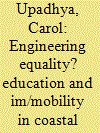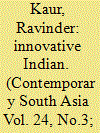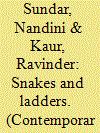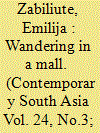|
|
|
Sort Order |
|
|
|
Items / Page
|
|
|
|
|
|
|
| Srl | Item |
| 1 |
ID:
147875


|
|
|
|
|
| Summary/Abstract |
This article traces the intersections between higher education, social mobility, and the reproduction of inequalities in Coastal Andhra Pradesh, India. It explores the social history, political economy, and culture of education in the region, and the formation of a dominant social imaginary that equates engineering degrees, IT jobs, and migration with social prestige and success. This aspirational culture has shaped mobility strategies across social classes, the educational regime, and government policies aimed at greater inclusion. But state interventions in engineering education have produced contradictory outcomes, creating paths of mobility for some social groups but new modes of marginalisation and immobility for others.
|
|
|
|
|
|
|
|
|
|
|
|
|
|
|
|
| 2 |
ID:
147880


|
|
|
|
|
| Summary/Abstract |
The idea of jugaad, or frugal innovation, has gained wide popularity within policy circles and business schools as a breakthrough formula – from a quick-fix solution grown in adverse conditions to a six-point business principle – for economic growth generation. I argue that the new jugaad innovation narrative offers an uplifting, potentially emancipatory discourse of mobility in a setting where even after two decades of economic reforms, wealth gap and poverty stubbornly persist. Central to this shift are two processes. First, a dramatic re-signification of the aam aadmi (common man), within a new conceptual scaffolding of India in relation to modern science and technology, where the ability to innovate is portrayed as a natural gift, a deeply ingrained collective Indian trait that even the unlettered common man possesses. Second, the conditions of adversity and absence of public services for Indian citizens are turned on its head to position India as an ideal laboratory condition within which a culture of innovation takes birth. In short, jugaad enables a dramatic transformation of what was once considered unchanging, static and immobile mass into a source of innovation, inspiration and ultimately socioeconomic mobility.
|
|
|
|
|
|
|
|
|
|
|
|
|
|
|
|
| 3 |
ID:
147876


|
|
|
|
|
| Summary/Abstract |
In this article, we portray the Indian experience of mobility and inequality since the early 1990 s. First, we address the question of heightening Indian inequality. Inequality has tended to rise substantially and can be understood in terms of the growing distance among social classes. Second, we present an analysis of migration in class terms and examine whether it has contributed to a reduction or heightening of inequality. Migrants as a group, across classes, have tended to do better than non-migrants at source and equivalent classes at destination. This finding is somewhat curious and counter-intuitive, and we explain it through the logic of endowments that these different groups possess. The better performance of the migrants has only further heightened the tendencies towards increasing inequality. Third, we analyse intergenerational occupational mobility to see if there is evidence for greater social mobility through the heightened presence of markets in our midst. Broadly, in an overall context of heightening inequality in India, it appears as if the forces fostering upward social mobility have not dominated over the forces that perpetuate social distance.
|
|
|
|
|
|
|
|
|
|
|
|
|
|
|
|
| 4 |
ID:
147879


|
|
|
|
|
| Summary/Abstract |
This paper investigates the role played by education as a mediator of inter-generational social mobility in India. It uses a nationally representative data set (the National Election Study 2009) to describe and establish patterns of social mobility in India, and subsequently, to establish the role played by education with regard to this mobility. In particular, it attempts to test the ‘merit’ argument by analysing whether the effect of social origins (class and caste; along with locality and gender) on mobility and on gaining access to one class destination (where education is expected to be critical) has declined, and whether education plays a role. However, while the paper finds high rates of inter-generational stability, rural–urban disaggregation complicates the broader picture. The role of education is also key, especially for women. The paper finds that education plays an important role with regard to social mobility chances, but the effect of caste and class of origin remains significant. Focusing on one class destination – the professional class – once we control for education, the impact of caste seems to vary, while the role played by class of origin remains statistically significant. The implications of these patterns by gender and locality are discussed.
|
|
|
|
|
|
|
|
|
|
|
|
|
|
|
|
| 5 |
ID:
147874


|
|
|
|
|
| Summary/Abstract |
The question of social mobility in a terrain of increasing inequality has gained particular urgency in post-reform India. We approach social mobility not as a one-way ascent toward the top, rather as a risk-laden enterprise prone to fluctuations that include both incremental gains and the possibility of sliding downwards. We argue that to ‘move up the ladder’ is not merely a matter of individual choice or hard work in the face of odds as free-market believers have long held. It is as much an outcome of collective political bargaining, privileges that dominant class and caste status affords, access to resources and, indeed, occasional luck. Two propositions follow. First, we suggest that the state remains albeit as a reluctant enabler of social mobility in the age of markets. Second, the participation in the new economy hinges also upon one’s ability to ‘dress up’ for the part, to be able to craft one’s look as if one belonged to spaces – work or leisure – that one desires to inhabit. The work of appearances, we suggest, does not operate at individual levels alone, it also encompasses the nation’s spectacular projection of itself in the global political economy.
|
|
|
|
|
|
|
|
|
|
|
|
|
|
|
|
| 6 |
ID:
147877


|
|
|
|
|
| Summary/Abstract |
In post-reform India, urban spaces have been redefined and reoriented towards the consumer public and are becoming increasingly segregated along class lines. While most of the scholarly attention has focused on the marginalization and segregation generated by anti-poor development in cities like Delhi, which aim to be ‘world-class’, less attention has been paid to the ways in which the poor experience the city and its middle-class consumer-oriented localities. In this article, I explore the ways in which urban poor young men who live in a squatter settlement on the fringes of the city aspire to social mobility as they wander in Delhi’s middle-class consumer-oriented spaces. Wandering (ghūmnā) is evaluated differently by young men and their parents, pointing to generational and gendered distinctions. For young men, such wandering is a means to participate in the consumer culture, while their families evaluate it as a waste of time and useless (bekār) behaviour. By placing aspirations in a temporal perspective, I show how the young men adjust their aspirations relationally, as they take up new roles as carers of their families.
|
|
|
|
|
|
|
|
|
|
|
|
|
|
|
|
|
|
|
|
|